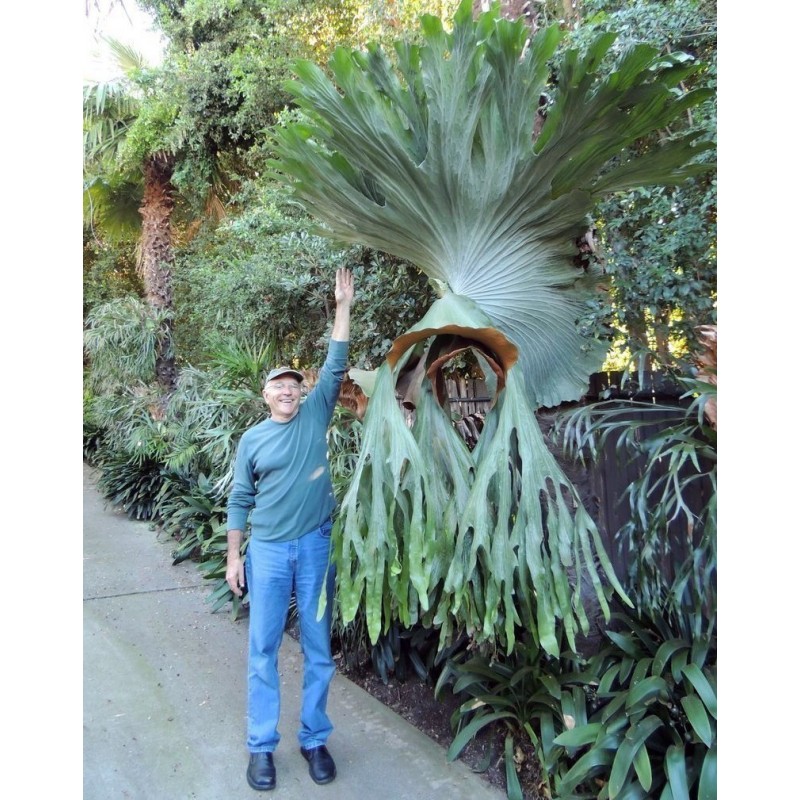Giant Staghorn Fern Seeds (Platycerium Superbum)
Price for Package of 50 seeds.
Platycerium superbum, commonly known as the Staghorn fern is found in Queensland, northern New South Wales and Malaysia. Platycerium is a genus of about 18 species of ferns, four of which occur in eastern Australia. Two, the elkhorn (Platycerium bifurcatum) and the staghorn (P.superbum) are well-known in cultivation.
Staghorns are generally epiphytic (growing on trees), or occasionally lithophytic (growing on rocks). These ferns have broad nest fronds, or sterile fronds, to 60 cm diameter, which grow and embrace the host and from a humus-collecting bowl, which can reach impressive dimensions of 1 metre across. The laminae of these fronds are erect and simple with deeply lobed upper margins. Fertile fronds are quite different in appearance, being broad at the base and hanging down from the plant, with forked laminae up to 200 cm in length and 2-6 cm wide. . The Staghorn entirely lacks the ability to produce plantlets, and the single plant simply gets larger each season. Brown sori, which contain spores, occur on the underside of the fertile fronds.
In nature, these ferns often grow high up in trees, where they receive much light filtering through the canopy. Similarly, plenty of light is important for good growth in cultivation and dense shade is resented. Filtered sunlight with some humidity is best.
Growing Platycerium from spore is not difficult given the right techniques and conditions. This species is frost tender and will not tolerate temperatures below 1*C. Some protection from drying wind is important, however, overwatering must be avoided. If the peaty centre remains continually wet, rot may occur and eventually kill the fern. Soaking intermittently, say, once weekly (but also depending on rainfall) is best. Fertilise with liquid organic fertilisers and sprinkle about 5g slow release fertiliser capsules into the bowl at intervals. Every few months place small pieces of aged hardened cow manure in the bowl. Staghorn ferns appreciate a slightly acidic environment and some growers find the remnants of a teapot emptied into the bowl to be helpful.
Because of their relatively large size, staghorn ferns are rarely grown in pots except when small specimens are purchased. Utilizing their natural growth habit, staghorn ferns are well suited for mounting on cypress wood or tree fern fiber plaque or wire baskets. To mount a fern on a slab of wood, place a few handfuls of growing medium on the wood slightly below center, shaping it in a circular mound. Place the fern on the medium so the bud is slightly below center of the mount and basal fronds are in contact with the medium. Using wire (not copper) or plastic stripping, secure the fern tightly to its mount. This same method is also used for tree fern fiber plaques. Wire baskets can also be used when packed with medium and hung so the top of the basket is vertical. The fern is secured to the basket using wire or plastic stripping. Clay pots can also be used if hung sideways.
Remounting to larger containers will be needed periodically as the fern grows. How often these are remounted depends on the size of the original mount, rate of medium breakdown, and growth rate of the fern. When the basal fronds reach the sides of the mount, it's time to place the fern on a larger mount. If the staghorn fern becomes too large, it may become impractical to remove the fern from its mount. In this case, enlarging the original mount periodically is suggested.










 Reviews (0)
Reviews (0)